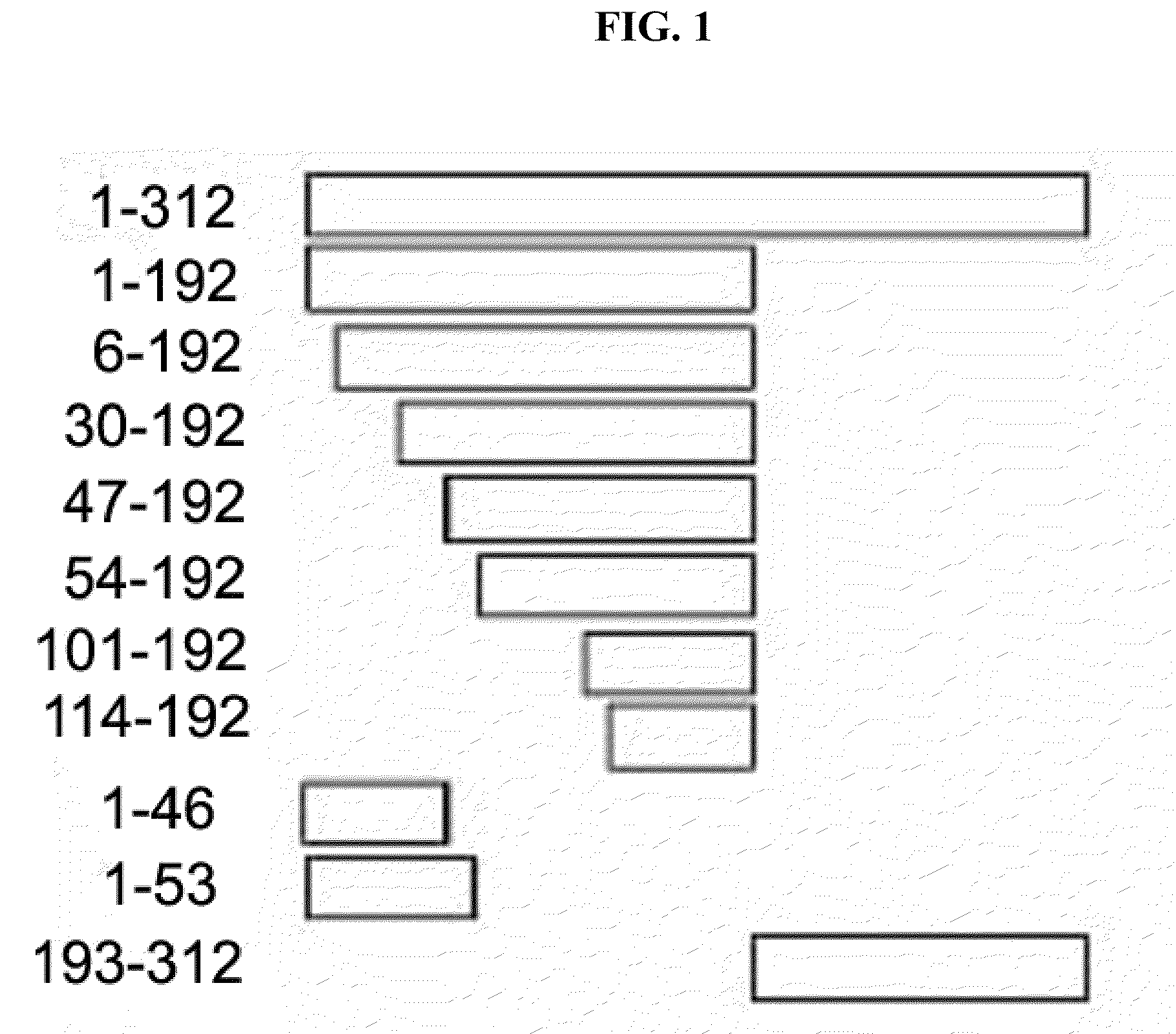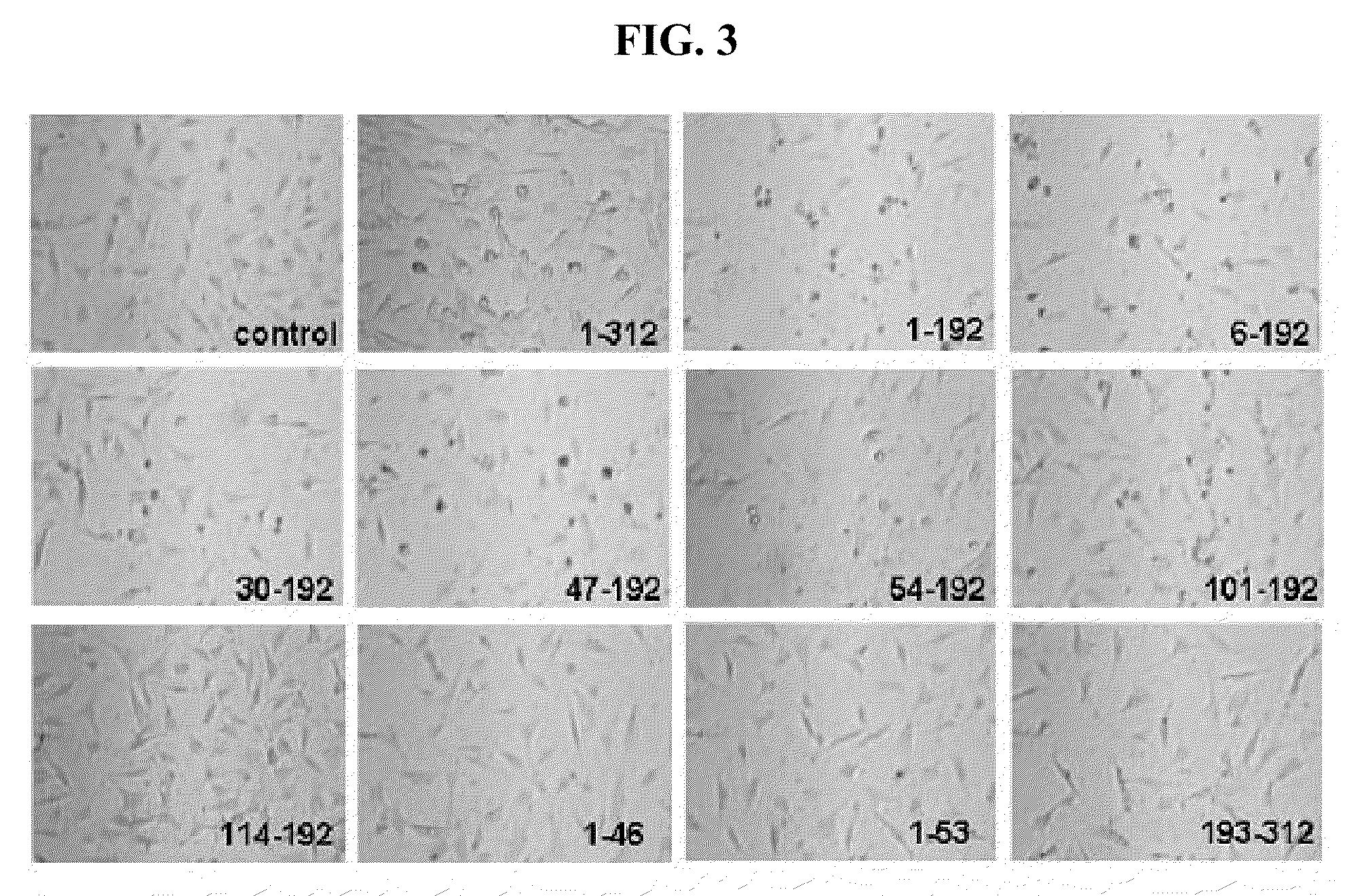Novel polypeptide having Anti-tumor activity
a polypeptide and anti-tumor technology, applied in the direction of peptides, apoptosis related proteins, drug compositions, etc., can solve the problems of peptide bond cleavage and tend to decompose, and achieve the effect of inhibiting cancer cell proliferation
- Summary
- Abstract
- Description
- Claims
- Application Information
AI Technical Summary
Benefits of technology
Problems solved by technology
Method used
Image
Examples
example 1
Construction of AIMP1 Protein or its Fragments
[0066]An AIMP1 consisting of 312 amino acids (SEQ ID NO: 1) was constructed according to the method of Park et al. (Park S. G. et al., J. Biol. Chem., 277:45243-45248, 2002).
[0067]Also, Each of deletion fragments of AIMP1 shown in FIG. 1, i.e., AIMP1-(1-192) (SEQ ID NO: 2), AIMPI-(6-192) (SEQ ID NO: 3), AIMP1-(30-192) (SEQ ID NO: 4), AIMP1-(47-192) (SEQ ID NO: 5), AIMP1-(54-192) (SEQ ID NO: 6), AIMP1-(101-192) (SEQ ID NO: 7), AIMP1-(114-192), AIMP1-(1-46), AIMP1-(1-53) and AIMP1-(193-312) fragments was constructed. Each of the fragments was synthesized by PCR using the cDNA of AIMP1 (SEQ ID NO: 1) as a template with specific primer sets (see Table 1). The PCR reaction conditions were as follows: pre-denaturation of template DNA by heating at 95° C. for 2 min; and then 30 cycles at 95° C. for 30 sec, 56° C. for 30 sec and 72° C. for 1 min; followed by final extension at 72° C. for 5 min.
TABLE 1SEQ. IDPrimerSequenceNOAIMP1-sense5′-CGGAATTC...
example 2
Identification of AIMP1 Domain Having Activity of Inducing Cell Death
Identification of Fragments Having Activity of Inducing Apoptosis Endothelial Cell
[0070]To confirm whether the deletion fragments of the AIMP1 constructed in the had cell death-inducing activity, the present inventors investigated the effect on cell death by treating BAECs (Bovine aorta endotheilial cells) with the fragments of AIMP.
[0071]BAECs (Bovine aorta endothelial cells) were isolated from descending thoracic aortas and grown in Dulbecco's modified Eagle's medium containing 20% fetal bovine serum at 37° C. in a 5% CO2 atmosphere. The cultured BAECs were treated with the deletion fragments of the AIMP1 (50 nM) for 24 h, and apoptotic cells were counted.
[0072]Concretely, enhanced green fluorescent protein (EGFP) were transfected into BAECs, and expressed for 24 h. The transfected cells were treated with the fragments of the AIMP1 (50 nM) for 24 h, and then cell death was determined by counting apoptotic cells...
example 3
Construction of Additional Deletion Fragments of AIMP1-(101-192) and Measurement of Their Activity
Construction of Additional Deletion Fragments of AIMP1-(101-192)
[0078]In order to more particularly determine cell death-inducing domain of AIMP1-(101-192) estimated to be a cell death-inducing domain in endothelial cell from the results in the , the present inventors constructed additional deletion fragments of AIMP1-(101-192).
[0079]As shown in FIG. 6, the present inventors constructed fragments from the AIMP1-(101-192) by serially deleting C-terminal part of the AIMP1-(101-192) with primers shown in Table.2. Particularly, the same method as in the was performed so as to construct and purify the above fragments. The purified proteins were identified by SDS-PAGE and the results were shown in FIG. 7.
TABLE 2PrimerSequenceSEQ. ID NOAIMP1-sense5′-CGGAATTCGCAGTAAC35(101-180)AACCGTATCTTCTGG-3′anti-5′-GTCTCGAGTTAATCTACTT36senseCTTCCACATACAAAGAATC-3′AIMP1-sense5′-CGGAATTCGCAGTAAC37(101-170)AA...
PUM
| Property | Measurement | Unit |
|---|---|---|
| pH | aaaaa | aaaaa |
| pH | aaaaa | aaaaa |
| pH | aaaaa | aaaaa |
Abstract
Description
Claims
Application Information
 Login to View More
Login to View More - R&D
- Intellectual Property
- Life Sciences
- Materials
- Tech Scout
- Unparalleled Data Quality
- Higher Quality Content
- 60% Fewer Hallucinations
Browse by: Latest US Patents, China's latest patents, Technical Efficacy Thesaurus, Application Domain, Technology Topic, Popular Technical Reports.
© 2025 PatSnap. All rights reserved.Legal|Privacy policy|Modern Slavery Act Transparency Statement|Sitemap|About US| Contact US: help@patsnap.com



